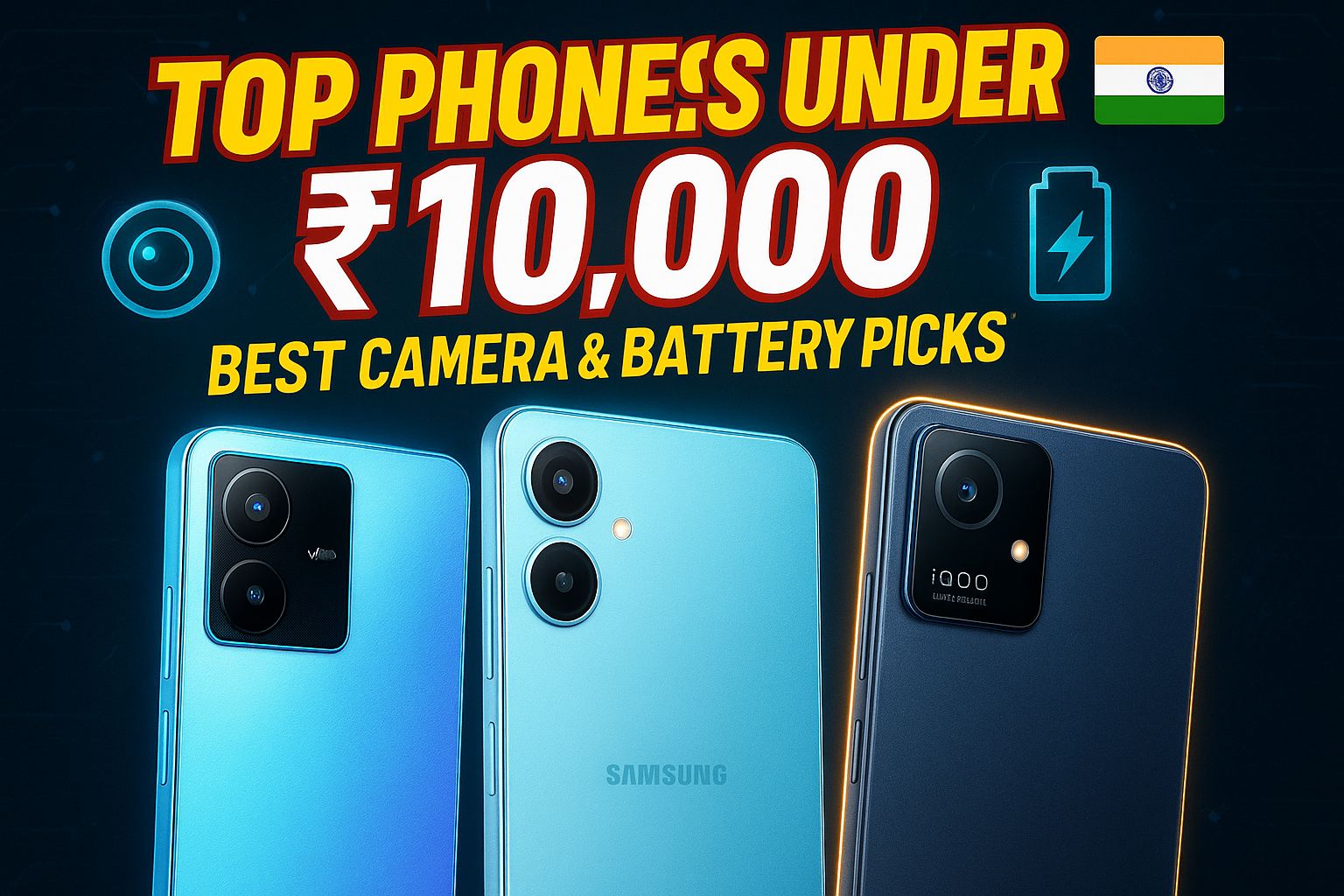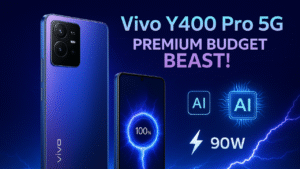Best Smartphones Under ₹10,000 in India
The Indian smartphone market under ₹10,000 has transformed significantly, now offering advanced features like 5G connectivity and high refresh rate displays, previously exclusive to pricier models. This guide provides a concise analysis of compelling options from Vivo, Samsung, and iQOO, along with other notable brands, focusing on camera, battery, display, and processor details to help consumers make informed decisions.
Understanding the Budget Segment: Key Features to Look For
When choosing a smartphone under ₹10,000, prioritize value for money by considering:
- 5G Connectivity: For future-proofing and faster speeds.
- Display Quality: Aim for HD+ resolution and preferably a 90Hz or 120Hz refresh rate for smoother visuals.
- Battery Life & Charging: A 5000mAh+ battery is standard for all-day use, with fast charging being a valuable addition.
- Camera Capabilities: Many feature 50MP primary sensors for decent photos in good light, but manage expectations for low-light performance.
- Processor & RAM: Octa-core processors (MediaTek Dimensity/Helio, Snapdragon 4 Gen 2) and at least 4GB RAM are recommended for smooth daily tasks.
- Software Experience: A clean Android interface with timely updates enhances long-term usability.
Vivo’s Value Proposition: Performance Meets Affordability
Vivo’s budget phones, especially the Y-series, offer sleek designs, decent cameras, and reliable battery life.
- Vivo Y17s: Priced around ₹9,499, it features a 6.56-inch HD+ 60Hz IPS LCD, MediaTek Helio G85 processor, 4GB RAM, 64GB/128GB storage (expandable to 1TB), a 50MP dual rear camera, 8MP front camera, and a 5000mAh battery with 15W fast charging. It runs Funtouch OS 13 based on Android 13 and has an IP54 rating.
- Vivo Y19e: Around ₹7,998, it has a 6.74-inch 90Hz display, Unisoc T7225 processor, 13MP dual rear camera, 5MP front camera, and a 5500mAh battery with fast charging.
Samsung’s Entry-Level Excellence: Reliability and Innovation
Samsung’s M-series and F-series are known for reliability, consistent performance, 5G integration, and good software support.
- Samsung Galaxy M06 5G: Ranges from ₹7,999 to ₹9,799. It features a 6.7-inch HD+ 90Hz PLS LCD with 800 nits brightness, MediaTek Dimensity 6300 processor, 4GB/6GB RAM, 64GB/128GB storage (expandable to 1TB), a 50MP dual rear camera, 8MP front camera, and a 5000mAh battery with 25W fast charging. It runs One UI Core 7.0 based on Android 15 with four years of Android upgrades promised.
- Samsung Galaxy F06 5G: Features a 6.7-inch HD+ screen, MediaTek Dimensity 6300 chip, 5000mAh battery with 25W fast charging, and runs One UI 7 based on Android 15, with Samsung’s commitment to software updates.
iQOO’s Performance Focus: Gaming and Power on a Budget
iQOO, a Vivo sub-brand, focuses on performance and large batteries, appealing to gamers.
- iQOO Z10 Lite 5G: The 4GB+128GB variant is ₹9,998. It has a 6.74-inch HD+ 90Hz display, MediaTek Dimensity 6300 processor, 4GB/6GB/8GB RAM, 128GB/256GB storage (expandable to 2TB), a 50MP dual rear camera, 5MP front camera, and a massive 6000mAh battery with 15W fast charging. It runs Funtouch OS 15 based on Android 15, with two years of OS updates and three years of security updates. It also has an IP64 rating.
Other Notable Contenders in the Sub-₹10,000 Segment
- POCO M7 5G: Starts around ₹8,799. Features a 6.88-inch HD+ 120Hz display, Snapdragon 4 Gen 2 processor, 6GB/8GB RAM, 128GB UFS 2.2 storage (expandable to 1TB), a 50MP main camera, 8MP front camera, and a 5160mAh battery with 18W fast charging (33W charger included). Runs Android 14 with HyperOS and has an IP52 rating.
- Infinix Hot 50 5G: Starts around ₹9,499. Features a 6.7-inch HD+ 120Hz display, MediaTek Dimensity 6300 processor, 4GB/8GB RAM, 128GB storage (expandable to 1TB), a 48MP triple rear camera, 8MP front camera, and a 5000mAh battery with 18W fast charging. Runs Android 14 with XOS 14, offers two years of software updates and three years of security updates, and has an IP54 rating.
- Redmi 14C 5G: Starts around ₹9,490. Features a 6.88-inch HD+ 120Hz IPS LCD, Snapdragon 4 Gen 2 processor, 4GB/6GB RAM, 64GB/128GB storage (expandable), a 50MP main rear camera, 8MP front camera, and a 5160mAh battery with 18W fast charging (33W charger included). Runs Android 14 with HyperOS, offers two years of software updates and four years of security updates, and has an IP52 rating.
Conclusion:
The sub-₹10,000 smartphone market in India now offers feature-rich devices with 5G and high refresh rates. Your best choice depends on your priorities:
- Battery Life: iQOO Z10 Lite 5G (6000mAh)
- Reliability & Software: Samsung Galaxy M06 5G or F06 5G
- High Refresh Rate & Performance: POCO M7 5G or Redmi 14C 5G (120Hz, Snapdragon 4 Gen 2)
- Balanced All-rounder: Vivo Y17s
This segment continues to evolve, providing excellent value for budget-conscious consumers.
FAQ Section
1. What are the most important features to look for in a smartphone under ₹10,000?
Key features include 5G connectivity, a large battery (5000mAh+), HD+ display (preferably 90Hz/120Hz), a capable octa-core processor, and a 48MP/50MP primary camera.
2. Do smartphones under ₹10,000 support 5G in India?
Yes, many new models from brands like Samsung, iQOO, POCO, Infinix, and Redmi in this price range now offer 5G connectivity.
3. What kind of camera quality can be expected from phones under ₹10,000?
Many feature 50MP primary rear cameras for decent, detailed photos in good lighting. However, low-light performance and secondary lens utility are generally limited.
4. Which phones offer the best battery life in this segment?
Many phones have 5000mAh or 6000mAh batteries. The iQOO Z10 Lite 5G (6000mAh) offers exceptional endurance, lasting over a day and a half with moderate use.
5. Are high refresh rate displays common in this budget?
Yes, 90Hz or 120Hz displays are increasingly common, providing smoother scrolling and animations, significantly enhancing the user experience.
6. What kind of processor performance can be expected for gaming?
Octa-core processors like MediaTek Dimensity/Helio or Snapdragon 4 Gen 2 are standard. They handle everyday tasks and light gaming smoothly, though demanding games may require lower graphical settings.
7. How important are software updates for budget phones?
Software updates are crucial for long-term security, new features, and improved performance. Brands like Samsung are known for providing multiple years of Android and security updates, adding significant value.


